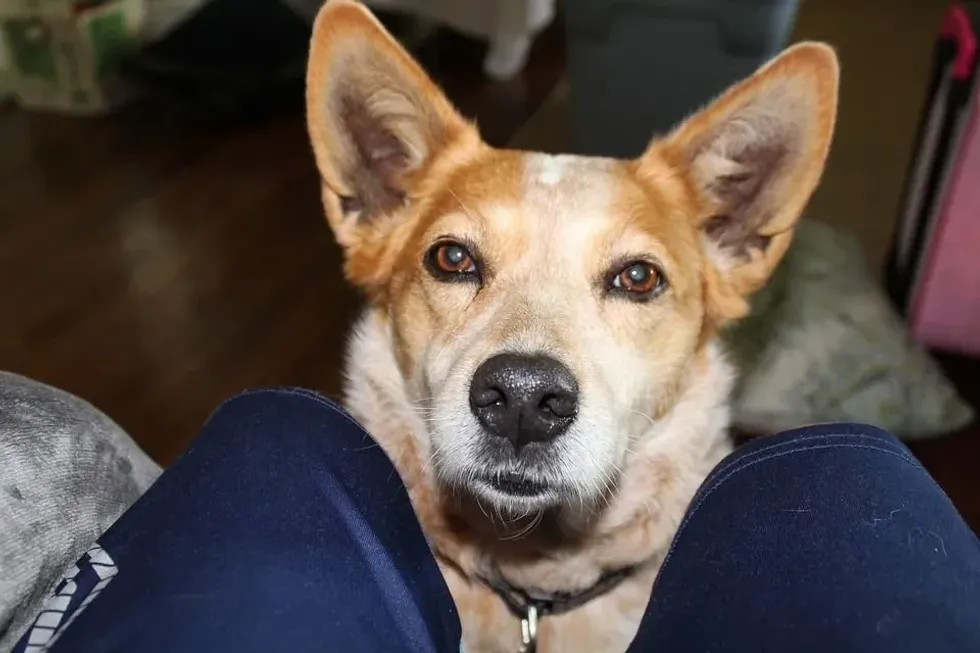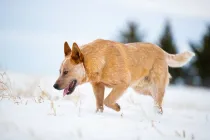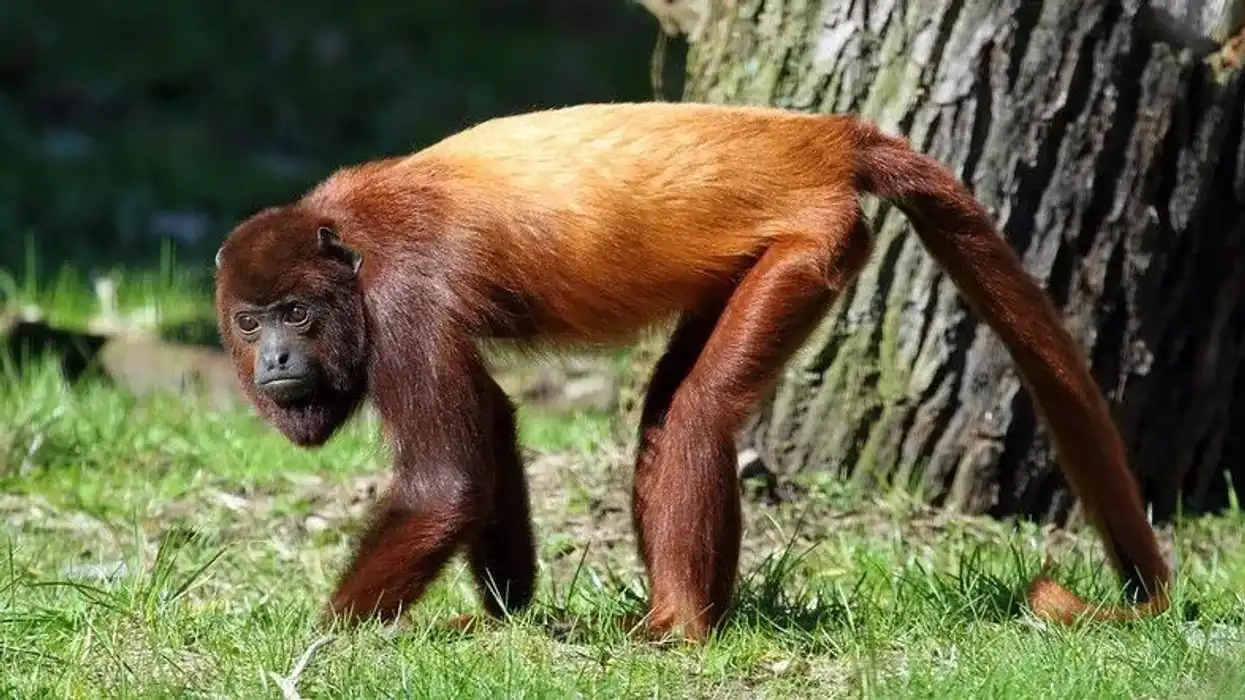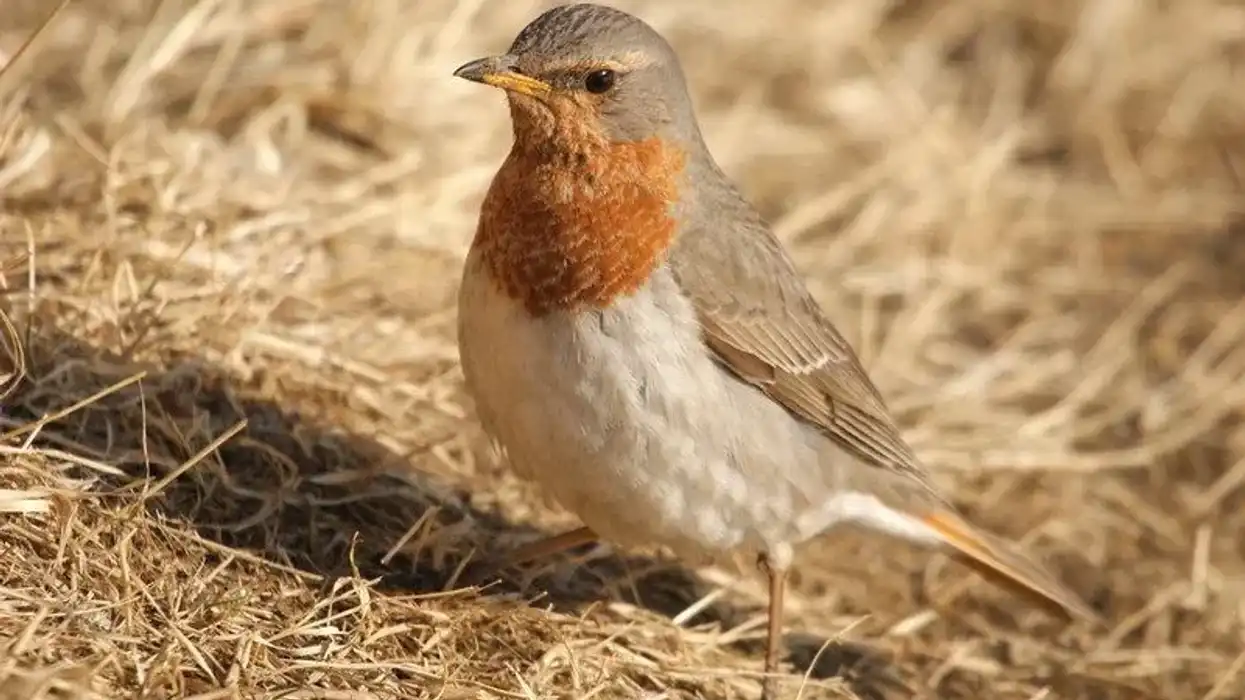Fun Red Heeler Facts For Kids
Content
- What type of animal is a Red Heeler?
- What class of animal does a Red Heeler belong to?
- How many Red Heelers are there in the world?
- Where does a Red Heeler live?
- What is a Red Heeler's habitat?
- Who do Red Heelers live with?
- How long does a Red Heeler live?
- How do they reproduce?
- What is their conservation status?
- What do Red Heelers look like?
- How cute are they?
- How do they communicate?
- How big is a Red Heeler?
- How fast can a Red Heeler run?
- How much does a Red Heeler weigh?
- What are the male and female names of the species?
- What would you call a baby Red Heeler?
- What do they eat?
- Are they hypoallergenic?
- Would they make a good pet?
- Did you know...
- Are Red Heelers dangerous?
- What is the difference between a Red Heeler and a Blue Australian Heeler?
Red Heelers are also known as Australian Cattle dogs, Australian Heelers, Hall’s Heelers, Australischer Treibhund, or Queensland Heelers. They are a crossbreed of tame dingoes and Blue Merle Collies or Smooth Collies.
Red Heeler dogs originated in Australia in the 1800s where they were bred as herding dogs. These dogs are hardy, enthusiastic, energetic, and well-suited to the rough terrain of Australia.
Though small in stature, they are good at their job without making much noise. Depending on the color of their coat, Australian Cattle dogs are either called Red Heelers or Blue Heelers. The name ‘heeler’ comes from their peculiar herding style of nipping on the heels of cattle to keep them moving ahead.
Australian ranchers found these intelligent, agile, loyal, active dogs with natural herding instincts to be an excellent fit as a herding or drover dog. Australian Cattle dogs are extremely fast learners and can be trained easily at a young age.
However, they like their freedom and have an independent attitude. This independent and bossy nature helps them to do their job well.
Though Australian Cattle dogs were bred to be working dogs that herd livestock, they are affectionate, loving, and very loyal to their owners. Inside the house, they are also good with children, are playful, and enjoy human company.
For more interesting animal facts, why not check out Victorian bulldog and Kunming wolfdog facts?
Red Heeler Interesting Facts
What type of animal is a Red Heeler?
Red Heelers, also known as Australian Cattle dogs, are herding dogs.
What class of animal does a Red Heeler belong to?
Red Heeler dogs are mammals.
How many Red Heelers are there in the world?
It is difficult to precisely say how many Red Heelers there are in the world. These Australian Cattle dogs, known as Queensland Heelers, are not only popular in Australia. They have won the hearts of dog lovers worldwide and are found in countries around the globe.
Where does a Red Heeler live?
As Red and Blue Heelers are dogs that Australian cattle are driven by, they mostly live on farms. This is the dog that Australian cattle ranchers use for herding livestock over long distances. In present times, this dog breed is also accepted as a popular house pet.
Australian Heelers need a good amount of exercise and activity. The medium size of a Red Heeler does not stop this dog breed from being an excellent herder. Farms and homes with open grounds are best suited for them.
What is a Red Heeler's habitat?
The rugged terrains and subtropical climate of New South Wales in Australia are most suitable for Red Heelers. Australian Heelers are working dogs with a high energy level and this cattle dog needs open space to run and exercise.
Red Heeler dogs do not originally belong to extremely cold climates, but this extremely energetic dog breed thrives well even in extremely cold weather and freezing temperatures. Their water-repellent double coat protects them from extreme cold, chilly wind, and even snow.
Who do Red Heelers live with?
Red Heelers live with people. They are herding dogs and their herding instincts may lead them to try and herd their family members by lightly nipping at their heels.
How long does a Red Heeler live?
The average Red Heeler lifespan is between 13 and 15 years.
How do they reproduce?
Like all mammals, Red Heelers reproduce sexually. The female dogs give birth to between one and seven puppies at a time. The average litter size of this breed is five.
What is their conservation status?
The conservation status of the Red Heelers is Least Concern.
Red Heeler Fun Facts
What do Red Heelers look like?
Red Heelers are medium-sized, compact, agile, muscular dogs. Their coat color may be red or blue.
A Red Heelers body is slightly longer than its height. This breed has thick, leathery, alert, pointy, and straight ears. They have an excellent auditory sense and can pick up the slightest of sounds. Their ears are set apart from each other in an outward direction from their head.
These dogs have intelligent-looking oval and dark eyes. They are not overly prominent or visibly sunken. They can give nasty stares to strangers and can communicate their emotions with their looks.
Their head is medium-sized, round and well balanced, and rightly proportionate to the size of the body. The head is flatter in the middle and curves slightly between their straight ears. Australian Heelers do not have a prominent cheekbone, although they have a muscular cheek with a visible under-jaw.
These dogs have a thick, all-weather coat that sheds twice a year. Red Heelers generally have red markings or speckles, a curved, hanging tail, muscular legs, and a thick, strong neck.
Puppies of this dog breed are born with a white coat. Red Heelers develop their tan markings, and Blue Heelers develop their blue gradually as they grow up. This breed also shows black, chocolate, blue mottled, and cream coats. Most kennel clubs around the world accept only two Heeler coat colors which are red and blue.
The face of these dogs usually has a mask or a patch over one or both eyes. Dogs without a patch are known as Plain-faced Heelers.
An average Red Heeler dog weighs between 33-49 lb (14-22 kg) and they are considered medium-sized dog breeds. Their size is advantageous for their active lifestyle and herding job.

How cute are they?
Red Heelers are herding dogs and cannot be called cute. However, they are extremely affectionate and loyal. They usually get along well with adults, children, and other pet dogs.
How do they communicate?
Red Heelers are not too vocal. They do not bark much when they have company, but they may bark at strangers or other dogs.
They often show their love by licking people. Heelers can give deadly stares when they are unhappy or want to scare you. They are very social and love to be with their human families. The dogs may suffer from separation anxiety when left alone for a long time.
How big is a Red Heeler?
When compared to Chihuahuas, the herding Red Heeler dogs are seven times heavier in weight and more than three times taller.
How fast can a Red Heeler run?
Australian Heelers are not one of the fastest dogs, but they can run at the speed of 25-30 mph (40-48 kmph).
How much does a Red Heeler weigh?
Red Heelers, or Australian Cattle dogs, have an average weight of 30-50 lb (13-22 kg).
What are the male and female names of the species?
Male Red Heelers are called dogs, and female Red Heelers are called bitches.
What would you call a baby Red Heeler?
A Red Heeler baby is called a puppy.
What do they eat?
Red Heeler puppies need good quality food as they are a highly active breed with high energy.
The amount of food an Australian Cattle dog requires to stay healthy completely depends on their size, weight, activity level, and similar factors. Dry dog food, kibble, some raw meat protein, as well as raw fruit and vegetables can be included in a Red Heeler’s diet.
Some raw food is required to provide enough energy for these herding dogs. Fruits and vegetables like raw carrots, cauliflower, broccoli, green peas, apples, bananas, pumpkin, and some raw meat also constitute their diet.
Home-cooked food for Red Heeler puppies may include organ meat, poultry, fish like tuna and salmon, and other animal protein. Their food should contain some carbohydrates like brown rice, barley, and sweet potato.
Other good sources of carbohydrates include sweet potato, brown rice, barley, and quinoa.
Being working dogs that need energy, stamina, and strength, Red Heeler puppies also require nutritional supplements. These tough dogs can be fed natural supplements like eggshells as a natural source of calcium. Specially formulated food rich in nutrients and a well-balanced diet can help these dogs maintain their all-weather double coat.
Are they hypoallergenic?
Red Heelers are not hypoallergenic. For allergy sufferers and asthma patients, this may not be the best dog breed to keep as a pet.
Would they make a good pet?
It will be wrong to assume that these are perfect pets, Red Heelers were bred to work with cattle, so they do not always make good pets. But, this breed is known for its loyalty, commitment, and affection for its family. They will always stick to their owner and guard the house.
All Australian Heelers are playful and make wonderful companions for adults as well as kids, including both Red Heelers and Blue Heelers. Their high energy level is ideal for keeping up with the activity level of kids of all ages.
This cattle dog needs plenty of exercise and thrives on activity. It best suits outdoorsy families who love venturing outside instead of chilling on the couch.
Exercise keeps the dogs mentally and physically stimulated. The enthusiastic Red Heelers and Blue Heelers are also good at dog sports. If they are not provided with an active lifestyle and adequate training, these dogs may develop behavioral problems.
Their herding instincts can often be seen in their effort to herd the family by nipping at their feet, especially the children. Red Heeler owners with toddlers should keep a careful watch to avoid accidental falls due to the overenthusiastic herding instinct of the dog.
This breed of dog is fun to be around if you don’t mind their plentiful energy and enthusiasm. Red Heeler puppies generally calm down at the age of four to six years.
These intelligent herding dogs are easy to train with a structured, stimulating, and consistent training routine. This breed is not too loud as they have a low-pitched bark.
They are happy to be around their owners and love company. When left alone, or confined in a small place, this dog breed is susceptible to separation anxiety or may get mischievous.
These dogs have a herding instinct which may lead to behaviors such as digging, chewing, and chasing. They love to run around and may not take to confined apartments living well.
Red Heelers are not slobbery and adapt well to most weather, including cold climates. Their shedding is average, but they have heavy sheds seasonally.
It is easy to groom Red Heeler dogs as they do not have a long coat and don’t shed heavily. Once in spring and once in fall, they shed their undercoats.
Their coat is not prone to bad odor and the dogs don’t need a bath regularly. Bathing them twice a month is good enough to keep their coat clean. Apart from that, occasional brushing, teeth and ear care, and attention to their nails are needed for good health.
Australian Red Heelers are not aggressive around their human family members but tend to show dog-provoked aggression and aggression towards strangers.
This robust, agile, sturdy, and healthy breed may face genetic health conditions known as canine hip dysplasia and elbow dysplasia. This causes a restriction in hip movement due to improper functioning of the ball and socket joint.
Progressive retinal atrophy or deterioration of eyesight is also a common genetic health condition prevalent among this herding breed.
Deafness is another common health condition that Red Heelers may develop. This may often be an inherited health condition. Similar to human deafness, canine deafness causes a reduction or loss of hearing power, which may become worse with age. In that case, a Red Heeler puppy can be trained to understand hand signals.
Bone-related health problems like spondylosis and arthritis often affect older Red and Blue Heelers. Symptoms of spondylosis may not be visible but bone spurs along the spine of the dog can be felt by running your fingers on the back of the dog.
Genetic makeup, old age, and obesity may lead to arthritis. In that case, the dog will be in pain and may have reduced mobility.
Pyometra and infertility are quite common in Red Heeler dogs. Pyometra is a health condition that arises due to bacterial infections like E. coli. Infertility can be caused by other factors such as improper breeding and ovulation problems in Red Heeler females.
Did you know...
Skidboot, the 2003 winner of Animal Planet’s Pet Star competition, was a working Blue Heeler ranch dog. His owner, David Hartwig, trained him to do some incredible tricks.
He won 25,000 USD by proving his intelligence and amazing mental ability. He was once called "The smartest dog in the world."
This extremely clever dog could learn tricks such as leading a horse on a leash, emptying the trash, and even performing at rodeos. This star dog made an appearance on famous shows such as 'Late Night With David Letterman', 'Jay Leno’s Tonight Show', 'Oprah Winfrey Show', and various other talk shows.
All Australian Heelers are born with a white coat. The red coat only starts showing after the dogs are around four weeks old.
Although Red Heelers originate from Australia, they have become a popular dog breed around the world. Owing to their intelligence, agility, and uniqueness, they are the world's 56th most popular dog breed.
Being one of the most intelligent dog breeds, in the 1940s, Red Heelers were trained to be used in shows as stunt dogs. Today, along with herding cattle and guarding the farms, these enthusiastic dogs participate and excel in several dog sports. Some of these sports are disc dog, flyball, and heelwork to music, rally, and obedience.
Red Heeler Border Collie mix breed combines the best characteristics of both working dog breeds. The coat color of Red Heeler mixes may differ and some of the puppies may resemble Border Collies or Heelers more.
Red Heelers mixed with Border Collies are excellent herders but are not as sprightly as Border Collies. They also take a comparatively laid-back attitude like their Red Heeler parent.
Red Heelers were primarily a mix between Australian Dingoes and English Sheepdogs. They were later crossed with several other breeds like Collies, Kelpies, and Dalmatians.
This was done to include all the desired traits of an intelligent and reliable herding dog. Australian Heeler puppies are born with a white coat, and this phenomenon is thought to be connected to the Dalmatian heritage.
Australian Heelers were not canine members of the American Kennel Club until 1983. The breed moved to the herding dog group from the working dog group as recently as 1985.
The officially verified oldest living dog, according to Guinness World Records, was a Blue Heeler named Bluey. This herding dog lived for more than 29 years on a farm.
Are Red Heelers dangerous?
Red Heelers are social dogs and enjoy human company. If not trained properly, the Red Heelers strong prey drive and instinct of nipping at heels may lead to biting habits which could become dangerous.
The dogs should be treated with respect and trained at an early age. These dogs are friendly with other pet dogs but the instinct to dominate other dogs of the same sex may lead to occasional aggression if not curbed with proper training.
What is the difference between a Red Heeler and a Blue Australian Heeler?
Red Heelers and Blue Heelers are the same dogs with only a difference in their coat color. Blue Heeler males and Blue Heeler females may have a litter where half the Heeler puppies may grow up to be red and the other half blue.
Here at Kidadl, we have carefully created lots of interesting family-friendly animal facts for everyone to discover! Learn more about some other mammals including German shepherd wolf mix, or Kangal.
You can even occupy yourself at home by drawing one of our red heeler coloring pages.
We Want Your Photos!
More for You
See All
Bachelor of Science specializing in Microbiology

Oluwatosin MichaelBachelor of Science specializing in Microbiology
With a Bachelor's in Microbiology from the Federal University of Agriculture, Abeokuta, Ogun State, Oluwatosin has honed his skills as an SEO content writer, editor, and growth manager. He has written articles, conducted extensive research, and optimized content for search engines. His expertise extends to leading link-building efforts and revising onboarding strategies.
Disclaimer
1) Kidadl is independent and to make our service free to you the reader we are supported by advertising. We hope you love our recommendations for products and services! What we suggest is selected independently by the Kidadl team. If you purchase using the Buy Now button we may earn a small commission. This does not influence our choices. Prices are correct and items are available at the time the article was published but we cannot guarantee that on the time of reading. Please note that Kidadl is a participant in the Amazon Services LLC Associates Program, an affiliate advertising program designed to provide a means for sites to earn advertising fees by advertising and linking to Amazon. We also link to other websites, but are not responsible for their content.
2) At Kidadl, we strive to recommend the very best activities and events. We will always aim to give you accurate information at the date of publication - however, information does change, so it’s important you do your own research, double-check and make the decision that is right for your family. We recognise that not all activities and ideas are appropriate for all children and families or in all circumstances. Our recommended activities are based on age but these are a guide. We recommend that these ideas are used as inspiration, that ideas are undertaken with appropriate adult supervision, and that each adult uses their own discretion and knowledge of their children to consider the safety and suitability. Kidadl cannot accept liability for the execution of these ideas, and parental supervision is advised at all times, as safety is paramount. Anyone using the information provided by Kidadl does so at their own risk and we can not accept liability if things go wrong.
3) Because we are an educational resource, we have quotes and facts about a range of historical and modern figures. We do not endorse the actions of or rhetoric of all the people included in these collections, but we think they are important for growing minds to learn about under the guidance of parents or guardians.







